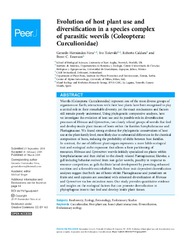Приказ основних података о документу
Evolution of host plant use and diversification in a species complex of parasitic weevils (Coleoptera: Curculionidae)
| dc.creator | Hernandez-Vera, Gerardo | |
| dc.creator | Toševski, Ivo | |
| dc.creator | Caldara, Roberto | |
| dc.creator | Emerson, Brent C. | |
| dc.date.accessioned | 2019-04-04T16:07:38Z | |
| dc.date.available | 2019-04-04T16:07:38Z | |
| dc.date.issued | 2019 | |
| dc.identifier.issn | 2167-8359 | |
| dc.identifier.uri | https://plantarum.izbis.bg.ac.rs/handle/123456789/564 | |
| dc.description.abstract | Weevils (Coleoptera: Curculionoidea) represent one of the most diverse groups of organisms on Earth; interactions with their host plants have been recognized to play a central role in their remarkable diversity, yet the exact mechanisms and factors still remain poorly understood. Using phylogenetic comparative analyses, here we investigate the evolution of host use and its possible role in diversification processes of Rhinusa and Gymnetron, two closely related groups of weevils that feed and develop inside plant tissues of hosts within the families Scrophulariaceae and Plantaginaceae. We found strong evidence for phylogenetic conservatism of host use at the plant family level, most likely due to substantial differences in the chemical composition of hosts, reducing the probability of shifts between host families. In contrast, the use of different plant organs represents a more labile ecological trait and ecological niche expansion that allows a finer partitioning of resources. Rhinusa and Gymnetron weevils initially specialized on plants within Scrophulariaceae and then shifted to the closely related Plantaginaceae; likewise, a gall inducing behavior evolved from non-galler weevils, possibly in response to resource competition, as galls facilitate larval development by providing enhanced nutrition and a favorable microhabitat. Results from trait-dependent diversification analyses suggest that both use of hosts within Plantaginaceae and parasitism on fruits and seed capsules are associated with enhanced diversification of Rhinusa and Gymnetron via low extinction rates. Our study provides quantitative evidence and insights on the ecological factors that can promote diversification in phytophagous insects that feed and develop inside plant tissues. | en |
| dc.publisher | PeerJ Inc. | |
| dc.relation | info:eu-repo/grantAgreement/MESTD/Integrated and Interdisciplinary Research (IIR or III)/43001/RS// | |
| dc.relation | Consejo Nacional de Ciencia y Tecnologia (CONACYT) Mexico | |
| dc.rights | openAccess | |
| dc.rights.uri | https://creativecommons.org/licenses/by/4.0/ | |
| dc.source | PEERJ | |
| dc.subject | Curculionidae | en |
| dc.subject | Host plant use | en |
| dc.subject | Insect-plant interactions | en |
| dc.subject | Diversification | en |
| dc.subject | Evolutionary ecology | en |
| dc.title | Evolution of host plant use and diversification in a species complex of parasitic weevils (Coleoptera: Curculionidae) | en |
| dc.type | article | |
| dc.rights.license | BY | |
| dc.citation.other | 7: - | |
| dc.citation.rank | M21 | |
| dc.citation.volume | 7 | |
| dc.type.version | publishedVersion | |
| dc.identifier.doi | 10.7717/peerj.6625 | |
| dc.identifier.fulltext | https://plantarum.izbis.bg.ac.rs//bitstream/id/1643/562.pdf | |
| dc.identifier.pmid | 30918760 | |
| dc.identifier.scopus | 2-s2.0-85063593163 | |
| dc.identifier.wos | 000461729000005 |


